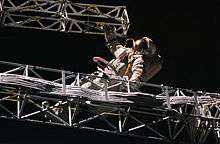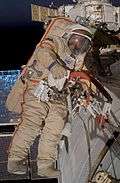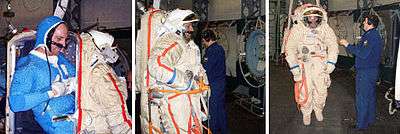Orlan space suit

The Orlan space suit (Russian: Орлан meaning sea eagle) is a series of semi-rigid one-piece space suit models designed and built by NPP Zvezda. They have been used for spacewalks (EVAs) in the Russian space program, the successor to the Soviet space program, and by space programs of other countries, including NASA. [1][2][3]
History
The first spacewalk using an Orlan suit took place on December 20, 1977, on the Soviet space station Salyut 6, during the Soyuz 26 mission. Yuri Romanenko and Georgi Grechko tested the Orlan-D space suit. The Orlan-DM was used for the first time on August 2, 1985, by the cosmonauts Vladimir Dzhanibekov and Viktor Savinykh of Salyut 7.
The Orlan space suits were used for spacewalks on the Salyut stations, but for Mir they were replaced by the Orlan-DMA and Orlan-M suits: The Orlan-DMA was used for the first time in November, 1988, by the cosmonaut Musa Manarov from the Mir space station. The Orlan-M continued in use on Mir from 1997 until the end of the station's operational life, and is now used on the International Space Station. Orlan space suits have been used by Russian, American, European and Chinese astronauts. China calls their Orlan-M suits Haiying (海鹰, the literal translation of Орлан into Chinese).
On February 3, 2006, a retired Orlan fitted with a radio transmitter, dubbed SuitSat-1, was launched into orbit from the International Space Station.[4][5][6]
In June 2009, the latest computerized Orlan-MK version was tested during a five-hour spacewalk to install new equipment on the International Space Station.[7] The new suit's main improvement is the replacement of the radio-telemetry equipment in the Portable Life Support System backpack which contains a mini-computer. This computer processes data from the spacesuit's various systems and provides a malfunction warning. It then outlines a contingency plan which is displayed on an LCD screen on the right chest part of the spacesuit.[7]
Design

The Orlan space suit has gone through several models. Space-rated designations include the Orlan-D, Orlan-DM, Orlan-DMA, and Orlan-M models; the Orlan-GN, Orlan-T, and Orlan-V are used in training and are used underwater.[8][9] The latest model, called Orlan-MK, was tested during a spacewalk in June, 2009.[7] The original Orlan suit, with a two and a half hour operation time, was designed as an orbital suit for use on the Soviet Lunar programme, although it was abandoned in favour of a model with a greater operating capacity. The Orlan-D expanded the operation time to three hours; the Orlan-M to nine hours.
The Orlan space suit is semi-rigid, with a solid torso and flexible arms.[10] It includes a rear hatch entry through the backpack that allows it to be donned relatively quickly (approximately five minutes). The first Orlan suits were attached to the spacecraft by an umbilical tether that supplied power and communications links. The Orlan-DM and later models are self-sustaining.
Models
Lunar orbit suit
- Name: Orlan Lunar orbital spacesuit
- Manufacturer: NPP Zvezda
- Missions: Development occurred from 1967-1971, no flight models were produced.[11]
- Function: Extra-vehicular activity (EVA)
- Operating pressure: 400 hPa (5.8 psi)[11]
- Suit weight: 59 kg (130 lb)[11]
- Primary life support: 5 hours[11]
D model

- Name: Orlan-D
- Manufacturer: NPP Zvezda
- Missions: Developed from 1969-1977. Used on Salyut-6 and Salyut-7. Used from 1977-1984.[11]
- Function: Extra-vehicular activity (EVA)
- Operating Pressure: 400 hPa (5.8 psi)[11]
- Suit Weight: 73.5 kg (162 lb)[11]
- Primary Life Support: 5 hours[11]
DM model
- Name: Orlan-DM
- Manufacturer: NPP Zvezda Company
- Missions: Used on Salyut-7 and Mir. Used from 1985-1988.[11]
- Function: Extra-vehicular activity (EVA)
- Operating pressure: 400 hPa (5.8 psi)[11]
- Suit weight: 88 kg (194 lb)[11]
- Primary life support: 6 hours[11]
DMA model

- Name: Orlan-DMA
- Manufacturer: NPP Zvezda
- Missions: Used on Mir. Used from 1988-1997.[11]
- Function: Extra-vehicular activity (EVA)
- Operating Pressure: 400 hPa (5.8 psi)[11]
- Suit Weight: 105 kg (231 lb)[11]
- Primary Life Support: 7 hours[11]
M model

- Name: Orlan-M
- Manufacturer: NPP Zvezda
- Missions: Used on Mir and ISS. Used from 1997-2009?[11]
- Function: Extra-vehicular activity (EVA)
- Operating Pressure: 400 hPa (5.8 psi)[11]
- Suit Weight: 112 kg (247 lb)[11]
- Primary Life Support: 7 hours[11]
MK model

- Name: Orlan-MK
- Manufacturer: NPP Zvezda
- Missions: Used on ISS. Used from 2009-present.[12]
- Function: Extra-vehicular activity (EVA)
- Operating pressure: 400 hPa (5.8 psi)
- Suit weight: 120 kg (260 lb)[12]
- Primary life support: 7 hours
MKS model
- Name: Orlan-MKS
- Manufacturer: NPP Zvezda
- Missions: To be used on ISS. And to possibly be introduced in 2015.[12]
- Function: Extra-vehicular activity (EVA)
- Operating pressure: 400 hPa (5.8 psi)
- Primary life support: 7 hours
Training
Orlan suits are used in the Yuri Gagarin Cosmonauts Training Center in Star City, Moscow: the Orlan-GN for water immersion training, the Orlan-T for airlock procedure training, and the Orlan-V for low gravity flight training.

See also
| Wikimedia Commons has media related to Orlan space suits. |
- Hard Upper Torso
- Liquid Cooling and Ventilation Garment
- Sokol space suit
- Soviet SPK
- List of spacewalks
- List of Mir spacewalks
- List of ISS spacewalks
- List of spacewalks and moonwalks
- List of cumulative spacewalk records
References
- ↑ NASA (1997). "NASA Press Briefing". National Aeronautics and Space Administration. Retrieved November 8, 2007.
- ↑ ESA (2004). "Orlan spacesuit". European Space Agency. Archived from the original on August 26, 2007. Retrieved November 8, 2007.
- ↑ Encyclopedia Astronautica (2007). "Orlan Space Suit". Encyclopedia Astronautica. Retrieved November 8, 2007.
- ↑ Tariq Malik (2006). "So Long, SuitSat: Astronauts Launch Spacesuit in ISS Spacewalk". Space.com. Retrieved November 8, 2007.
- ↑ Robert Z. Pearlman for CollectSpace.com (2006). "Orlan Overboard: The Suit Behind the Sat". Space.com. Retrieved November 8, 2007.
- ↑ Space Today Online (2006). "Suitsat: An empty spacesuit broadcasting to Earth". Space Today Online. Retrieved November 8, 2007.
- 1 2 3 "ISS astronauts complete spacewalk, test new Russian spacesuits". RIA Novosti. 2009-06-05. Retrieved 2009-06-10.
- ↑ NPP InterCoS (2007). "Zvezda's Museum and Spacesuit Photo Report". NPO International Cooperation in Space. Retrieved November 8, 2007.
- ↑ Jonathan McDowell (2000). "The History of Spaceflight Chapter 7.2: Zvezda Orlan spacesuits". Retrieved November 8, 2007.
- ↑ JSC RD&PE "Zvezda". "Space Suits". JSC RD&PE "Zvezda", Russia. Retrieved November 8, 2007.
- 1 2 3 4 5 6 7 8 9 10 11 12 13 14 15 16 17 18 19 20 Isaac Abramov & Ingemar Skoog (2003). Russian Spacesuits. Chichester, UK: Praxis Publishing Ltd. ISBN 1-85233-732-X.
- 1 2 3 RuSpace
